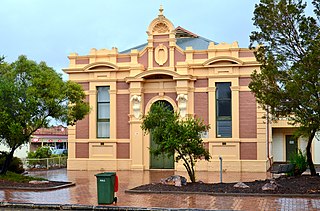
Port Augusta is a small city in South Australia. Formerly a seaport, it is now a road traffic and railway junction city mainly located on the east coast of the Spencer Gulf immediately south of the gulf's head and about 322 kilometres (200 mi) north of the state capital, Adelaide. The suburb of Port Augusta West is located on the west side of the gulf on the Eyre Peninsula. Other major industries included, up until the mid-2010s, electricity generation. At June 2018, the estimated urban population was 13,799, having declined at an average annual rate of -0.53% over the preceding five years.

The City of Port Augusta is a local government area located at the northern end of Spencer Gulf in South Australia. It is centred on the town of Port Augusta. The city was the site of South Australia's main power supplier, the Port Augusta powerhouse, located on the coast of the Spencer Gulf.

William Tennant Mortlock was a South Australian grazier and politician.

Wooltana Station most commonly known as Wooltana is a pastoral lease that operates as a sheep station in outback South Australia. It lies on what were formerly the lands of the Pilatapa.
Lindsay Gordon Riches, CMG was a South Australian politician. He was a Labor Party member of the South Australian House of Assembly from 1933 to 1970, representing the electorates of Newcastle (1933-1938) and Stuart (1938-1970). He was Speaker of the South Australian House of Assembly from 1965 to 1968 under Frank Walsh and Don Dunstan. He was also a long-time mayor of the City of Port Augusta from 1936 to 1970, with Port Augusta gaining city status during his tenure.
James Michael Beerworth was a South Australian Labor Party politician.
John Edward Pick was an Australian pastoralist and politician. He represented the South Australian House of Assembly multi-member seat of Burra Burra from 1915 to 1918. He was sometimes referred to as "the grand old man of the north-west".

Murtho is a locality in South Australia. It is northeast of Renmark and Paringa. It is bounded by the Murray River on its north and west sides and the Victorian border on the east.

The District Council of Woolundunga was a local government area in South Australia from 1888 until 1933.

The Corporate Town of Davenport was a local government area in South Australia that existed from 1887 to 1932 on land now located within the suburb of Port Augusta.

The Corporate Town of Semaphore was a local government area in South Australia. It was created on 20 December 1883, and re-gazetted on 17 January 1884, from areas which had been part of the District Council of Lefevre's Peninsula and District Council of Glanville. The separation of Semaphore would make both its former municipalities unviable, with Lefevre's Peninsula subsequently merging into the District Council of Birkenhead and Glanville with the District Council of Woodville. In 1889, the municipality acquired the Semaphore Institute building for use as the Semaphore Town Hall; the building survives today as the heritage-listed Semaphore Library. It amalgamated with the Corporate Town of Port Adelaide on 11 November 1900.

The District Council of Port Germein was a local government area in South Australia, centred on the town of Port Germein. It was gazetted on 5 January 1888 under the provisions of the District Councils Act 1887 and encompassed the hundreds of Baroota, Wongyarra, Booleroo, Telowie, Darling and Appila. It replaced an abortive earlier municipality, the Corporate Town of Port Germein, which had been established on 15 September 1887 when residents, concerned about increased taxation and their interests being lost in a broader shire under the forthcoming reforms, decided to incorporate the town. The local residents reportedly regretted the decision, and when the Act passed late in the year creating the new District Council, state parliament agreed to amalgamate the Corporate Town into the new municipality.

The District Council of Kanyaka was a local government area in South Australia that existed from 1888 to 1969.

The District Council of Hawker was a local government area in South Australia from 1888 to 1997, centred on the town of Hawker. At its creation it was the northernmost local government area in the state.

The Quorn Town Hall is a heritage-listed former town hall at 20 Railway Terrace, Quorn, South Australia. It was added to the South Australian Heritage Register on 12 January 1984; it is also listed on the Register of the National Estate.

The District Council of Orroroo was a local government area in South Australia, centred on the town of Orroroo. It was gazetted on 5 January 1888 under the provisions of the District Councils Act 1887 and included all the land defined by the hundreds of Black Rock Plain, Coomooroo, Erskine, Pekina, and Walloway in the County of Dalhousie.

Saltia is a locality in the Australian state of South Australia located on the western side of the Flinders Ranges about 279 kilometres (173 mi) north of the state capital of Adelaide and about 19 kilometres (12 mi) east of the city of Port Augusta.

The County of Frome is one of the 49 cadastral counties of South Australia in straddling the Mid North and Flinders Ranges regions. It was proclaimed in 1851 by Governor Henry Young and was named for the former Surveyor-General of South Australia, Edward Charles Frome. The iconic Mount Remarkable in the Hundred of Gregory is at the centre of the county.

Woolundunga is a locality in the Australian state of South Australia located on the western side of the Flinders Ranges about 271 kilometres (168 mi) north of the state capital of Adelaide and about 21 kilometres (13 mi) south-east of the city of Port Augusta.
Dr John Woodforde was a medical professional, one of the earliest settlers to the British colony of South Australia and its capital, Adelaide.








